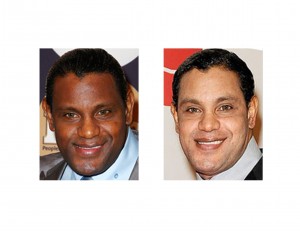The recent controversy regarding the potential skin color change of Sammy Sosa is fraught with issues of history and culture. If you’ve seen recent photos of him, it is easy to see why it has stirred up such debate. My last visual memory of him was that his skin color was closer to mahogany, not the off white of recent photos taken at the Latino Grammy Awards. His explanation for the appearance of his skin was that it was from a combination of a skin rejuvenation process and the bright TV lights at the awards show. Which, quite frankly, I don’t believe. There are too many shades of difference coming from such dark skin to start.
A similar but milder issue was raised with Beyonce from a recent L-Oreal ad where her skin appeared much lighter. The company denied any alterations, chemically or digitally produced, and credited the lighting from the photo shoot. This I do believe as it is but a shade or two lighter from skin which isn’t as dark as Sammy Sosa’s originally was.
One concept to grasp is that specific zones of abnormally high pigmentation can be reduced by topical creams or gels. In cases of vitiligo (loss of skin pigment), the condition that Michael Jackson allegedly had, the surrounding skin may be lightened to achieve a more uniform appearance. Zone depigmentation has also been successfully used to reduce the typically darker pigmentation of the genital and perianal area. However, in cases where these spot treatment creams are used in attempt to lighten the entire complexion, all of the current topical creams are ineffective for that purpose. Complete skin depigmentation on a wide scale is not possible. So to say that someone can lighten their complexion significantly by a topical agent alone is fantasy, not medical reality.
But these celebrity issues, as interesting or controversial as they may be, bring attention to the treatment of a different but very common skin problem…that of hyperpigmentation. Reactive hyperpigmentation comes from a variety of causes, the most common in a plastic surgery or dermatology practice, is from pregnancy (chloasma), as a reaction to many available skin rejuvenation treatments. (e.g., chemical peels, lasers) known as melasma, and from long-term sun exposure. (solar lentigenes)
Most skin-lightening treatments that are used today can reduce or block some melanin production and do so by inhibiting the enzyme tyrosinase. Many treatments use a combination of topical lotions or gels containing melanin-inhibiting ingredients along with a sunscreen, and a prescription retinoid or RetinA derivative. Depending on how the skin responds to these treatments, we can progress to skin exfoliation through chemical peels or light-activated devices.
Drugs make up the primary treatment approach for pigmentation problems. Hydroquinone is the gold standard to which other agents are compared. Topical hydroquinone comes in 2% (available in cosmetics) to 4% (or more) concentrations (by prescription). More recently it has been combined with tretinoin in a very effective cream known as Tri-Luma. Research has shown that the combination of hydroquinone and tretinoin to be very effective against sun- or hormone-induced melasma and it is a great combination for the treatment and prevention of wrinkles as well.
Hydroquinone has come under some fire because has been shown to cause leukemia in laboratory animals. As a result, Europe banned in 2001 and rumors continue to float that it may eventually be banned in the United States as well. But for now it remains available as an over-the-counter drug, but with a concentration not exceeding 2 percent. Alternatives to hydroquinone is azelaic acid in 15% to 20% concentrations and Kojic acid which is usually combined with glycolic acid.
Dr. Barry Eppley
Indianapolis, Indiana




